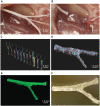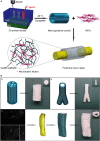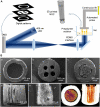Additive Manufacturing of Nerve Guidance Conduits for Regeneration of Injured Peripheral Nerves
- PMID: 33102468
- PMCID: PMC7546374
- DOI: 10.3389/fbioe.2020.590596
Additive Manufacturing of Nerve Guidance Conduits for Regeneration of Injured Peripheral Nerves
Abstract
As a common and frequent clinical disease, peripheral nerve defect has caused a serious social burden, which is characterized by poor curative effect, long course of treatment and high cost. Nerve autografting is first-line treatment of peripheral nerve injuries (PNIs) but can result in loss of function of the donor site, neuroma formation, and prolonged operative time. Nerve guidance conduit (NGC) serves as the most promising alternative to autologous transplantation, but its production process is complicated and it is difficult to effectively combine growth factors and bioactive substances. In recent years, additive manufacturing of NGCs has effectively solved the above problems due to its simple and efficient manufacturing method, and it can be used as the carrier of bioactive substances. This review examines recent advances in additive manufacture of NGCs for PNIs as well as insight into how these approaches could be improved in future studies.
Keywords: additive manufacturing; biomaterial; nerve guidance conduit; nerve regeneration; peripheral nerve.
Copyright © 2020 Song, Wang, Wang, Yu, Hou, Zhu and Li.
Figures





Similar articles
-
Advances in Biomimetic Nerve Guidance Conduits for Peripheral Nerve Regeneration.Nanomaterials (Basel). 2023 Sep 10;13(18):2528. doi: 10.3390/nano13182528. Nanomaterials (Basel). 2023. PMID: 37764557 Free PMC article. Review.
-
Nerve guide conduits for peripheral nerve injury repair: A review on design, materials and fabrication methods.Acta Biomater. 2020 Apr 1;106:54-69. doi: 10.1016/j.actbio.2020.02.003. Epub 2020 Feb 8. Acta Biomater. 2020. PMID: 32044456 Review.
-
Additive manufacturing of peripheral nerve conduits - Fabrication methods, design considerations and clinical challenges.SLAS Technol. 2023 Jun;28(3):102-126. doi: 10.1016/j.slast.2023.03.006. Epub 2023 Apr 5. SLAS Technol. 2023. PMID: 37028493 Review.
-
Nanoparticles for neurotrophic factor delivery in nerve guidance conduits for peripheral nerve repair.Nanomedicine (Lond). 2022 Mar;17(7):477-494. doi: 10.2217/nnm-2021-0413. Epub 2022 Feb 28. Nanomedicine (Lond). 2022. PMID: 35220756 Review.
-
Polymeric Guide Conduits for Peripheral Nerve Tissue Engineering.Front Bioeng Biotechnol. 2020 Sep 25;8:582646. doi: 10.3389/fbioe.2020.582646. eCollection 2020. Front Bioeng Biotechnol. 2020. PMID: 33102465 Free PMC article. Review.
Cited by
-
Fabrication Techniques of Nerve Guidance Conduits for Nerve Regeneration.Yonsei Med J. 2022 Feb;63(2):114-123. doi: 10.3349/ymj.2022.63.2.114. Yonsei Med J. 2022. PMID: 35083896 Free PMC article. Review.
-
Fabrication and Characterization of Polycaprolactone/Chitosan-Hydroxyapatite Hybrid Implants for Peripheral Nerve Regeneration.Polymers (Basel). 2021 Mar 3;13(5):775. doi: 10.3390/polym13050775. Polymers (Basel). 2021. PMID: 33802478 Free PMC article.
-
Advances in Biomimetic Nerve Guidance Conduits for Peripheral Nerve Regeneration.Nanomaterials (Basel). 2023 Sep 10;13(18):2528. doi: 10.3390/nano13182528. Nanomaterials (Basel). 2023. PMID: 37764557 Free PMC article. Review.
-
Controlling the Spatiotemporal Release of Nerve Growth Factor by Chitosan/Polycaprolactone Conduits for Use in Peripheral Nerve Regeneration.Int J Mol Sci. 2022 Mar 5;23(5):2852. doi: 10.3390/ijms23052852. Int J Mol Sci. 2022. PMID: 35269991 Free PMC article.
-
The GDNF-gel/HA-Mg conduit promotes the repair of peripheral nerve defects by regulating PPAR-γ/RhoA/ROCK signaling pathway.iScience. 2024 Jan 19;27(2):108969. doi: 10.1016/j.isci.2024.108969. eCollection 2024 Feb 16. iScience. 2024. PMID: 38322994 Free PMC article.
References
Publication types
LinkOut - more resources
Full Text Sources
Other Literature Sources
Research Materials

